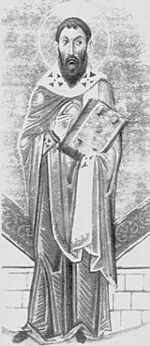Sophronius of Jerusalem facts for kids
Quick facts for kids SaintSophronius |
|
|---|---|

Saint Sophronius of Jerusalem
|
|
| Patriarch of Jerusalem | |
| Born | c. 560 Damascus, Byzantine Empire |
| Died | 11 March 638 (aged 77–78) Jerusalem, Rashidun Caliphate |
| Venerated in | Eastern Orthodox Church, Roman Catholic Church |
| Feast | 11 March [O.S. 24 March (where the Julian calendar is used)] |
| Attributes | Vested as a bishop, with right hand upheld in blessing, holding a Gospel Book or scroll |
Sophronius (Greek: Σωφρόνιος; Arabic: صفرونيوس; around 560 – March 11, 638) was a very important religious leader. He was known as Sophronius the Sophist because he was a skilled speaker. From 634 until he passed away, he served as the Patriarch of Jerusalem.
Sophronius is honored as a saint in both the Eastern Orthodox and Catholic Churches. Before becoming Patriarch, he was a monk and a theologian. A theologian is someone who studies religious beliefs. He was a strong defender of the true teachings about Jesus. He also helped negotiate the peaceful surrender of Jerusalem to the Muslim leader Umar ibn al-Khattab.
Contents
Sophronius's Early Life and Journeys
Sophronius was born in a city called Damascus around the year 560. Some people believe he was from a Greek family, while others think he was Syriac. He was a teacher of rhetoric, which is the art of speaking and writing well.
Around 580, Sophronius became an ascetic in Egypt. An ascetic is someone who lives a very simple life, often for religious reasons. Later, he joined the monastery of St. Theodosius near Bethlehem. He traveled a lot, visiting monasteries in places like Asia Minor, Egypt, and Rome.
He often traveled with a famous writer named St. John Moschus. Moschus even dedicated his book, Spiritual Meadow, to Sophronius. When Moschus died in Rome in 619, Sophronius brought his body back to Jerusalem for burial.
Fighting for Christian Beliefs
In 633, Sophronius traveled to Alexandria, Egypt, and to Constantinople. He wanted to convince the church leaders there to reject a teaching called Monoenergism. This teaching said that Jesus only had a divine "energy" and not a human ability to choose. Sophronius believed this was wrong.
He argued that Jesus was fully human and fully divine. Sadly, most of his writings about this important topic are now lost. Only a letter he wrote for a big church meeting, the Third Council of Constantinople, still exists.
Becoming Patriarch of Jerusalem
Even though he wasn't fully successful in stopping Monoenergism, Sophronius was chosen as the Patriarch of Jerusalem in 634. This was a very important leadership role in the church.
Soon after, he sent a special letter to Pope Honorius I and other Eastern patriarchs. In this letter, he clearly explained the correct Christian belief. He stated that Christ has two natures: one human and one divine. He argued that Monoenergism was a hidden form of another wrong teaching called Monophysitism. Monophysitism claimed Jesus had only one divine nature.
Sophronius also put together a collection of writings from early church leaders. This collection, called a Florilegium, had about 600 texts. They supported the idea of Dyothelitism, which means Jesus had both a human will and a divine will. This important document is also lost today.
Sophronius's Views and Legacy
In his Christmas sermon in 634, Sophronius focused on making sure his clergy followed the accepted Christian view of God. He also mentioned the advance of the Saracen (Muslim) armies into Palestine. He noted that the Saracens already controlled Bethlehem.
Sophronius saw the Saracen control as a way God was correcting Christians who were not strong in their faith. He died soon after Jerusalem fell to the caliph Umar I in 637.
Before his death, he negotiated an important agreement. This agreement, known as Umari Treaty, allowed Christians to keep their civil and religious freedom. In return, they agreed to pay a tribute. Caliph Umar himself came to Jerusalem and met with Sophronius at the Church of the Holy Sepulchre. Sophronius even invited Umar to pray there. However, Umar politely declined, saying he didn't want to risk changing the church's status as a Christian holy place.
Sophronius's Writings
Besides his writings on theological debates, Sophronius also wrote other important works. He wrote a praise-filled speech about the martyrs Cyrus and John. He did this because he believed they helped cure his failing eyesight.
He also wrote 23 poems in a classical style called Anacreontic. These poems covered topics like the Muslim siege of Jerusalem and various church celebrations. His poems Anacreontica 19 and 20 show how much he missed Jerusalem when he was away.
These two poems describe a full tour of the most important holy places in Jerusalem around the end of the 6th century. This time was seen as a golden age for Christianity in the Holy Land. Poem 20 talks about the gates of Jerusalem, the Anastasis (Church of the Holy Sepulchre), the Rock of the Cross, the Constantinian Basilica, Mount Sion, the Praetorium, St. Mary at the Probatica, and Gethsemane. Poem 19 then mentions the Mount of Olives, Bethany, and Bethlehem.
Sophronius also wrote the story of St. Mary of Egypt. This story is still read in churches today during the fifth Thursday of Lent in the Byzantine Rite.

